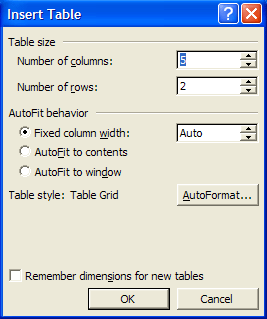Word XP
Working with Tables
Introduction
By the end of this lesson, learners should be able to:
- Construct Tables
- Enter Text and Numbers into Tables
Working with Tables
Tables allow large amounts of text and/or numbers to be presented in an organized and easy to read fashion. Student roll books, sport statistics, address books, math formulas, menus and many other documents often incorporate tables to share information.
Similar to columns, Tables can be challenging at first. Word has created an entire menu to help assist you in creating your first Table.
A few important terms to know before you begin creating tables are:
Row - A row runs horizontal in a table and is divided by borders.
Borders - Separating lines in the table.
Column - A column runs perpendicular in a table and is divided by borders.
Cell - A cell is the box that is created when your rows and your columns intersect each other. The cell contains your data or information.

Creating Tables Using the Insert Table Dialog Box:
- Click Table on the Menu Bar.
- Select Insert and then Table from the cascading menu. The Insert Table dialog box appears.
- Determine the number of columns and rows you need in your table. You can add more later, but save yourself some work. You can always add rows by pressing Tab at the end of a row.
- To create a table as wide as your page, leave the Fixed Column Width setting on Auto.
- Click OK. A table is inserted into your document.

Another automated way to create a quick table is by using the Insert Table Button on the Standard toolbar.
Creating Tables Using the Insert Table Button:
- Click the Insert Table Button
 .
. - Now, drag the number of columns and rows you want in your table.

Custom-Made Tables
The Insert Table Dialog Box and Insert Table button offer a quick solution to making tables. If you would like to custom create your table by drawing it yourself, you can use the Draw Table button.
Creating Tables Using the Draw Tables Button:
- Open the Tables and Borders toolbar by clicking View on the Menu Bar, Select Toolbars and then Tables and Borders from the Cascading Menu. The Tables and Borders toolbar will appear.
- Click the Draw Tables button on the Tables and Borders toolbar. The mouse pointer turns into a pencil.

- Drag the pencil to create a rectangle about the size of the table you want.
- Release the mouse button. The border of the table appears in your document.
- Use the pencil again to draw in column and row borders.
- Click the Draw Table button again to change the pencil back into an I-beam.
If you make a mistake while drawing your table, you can erase both rows and columns by using the Eraser on the Tables and Borders toolbar. Once you select the Eraser, the pointer will change to resemble the Eraser Button. Drag the Eraser over parts of the table you wish to erase. When you are finished erasing, click the Eraser button again to put the Eraser away.
Drag the Eraser over parts of the table you wish to erase. When you are finished erasing, click the Eraser button again to put the Eraser away.
Entering Text
Click inside any table cell to begin entering text or numbers.

Moving Around in a Table:
- Use the Tab key or right arrow key to move right.
- Use Shift + Tab or the left arrow key to move left.
- The up and down arrow keys will move the insertion point above or below its current location.
Selecting Text in Tables:
A cell: triple click inside cell.
A row: Move mouse to left of margins, point to the row, and click.
Multiple rows: Select the first row, click and drag the number of rows desired.
A column: Move the mouse above the column. It turns into a downward pointing arrow. Click once.
Multiple columns: Select the first column, click and drag the number of columns desired.
Entire Table: Choose Table and Select Table from the menu bar.
Challenge!
- Open a new Word document.
- Create a table using one of the three ways mentioned in this lesson.
- Insert some text into the table.
- Practice moving the insertion point around the table.
- Delete the table.


